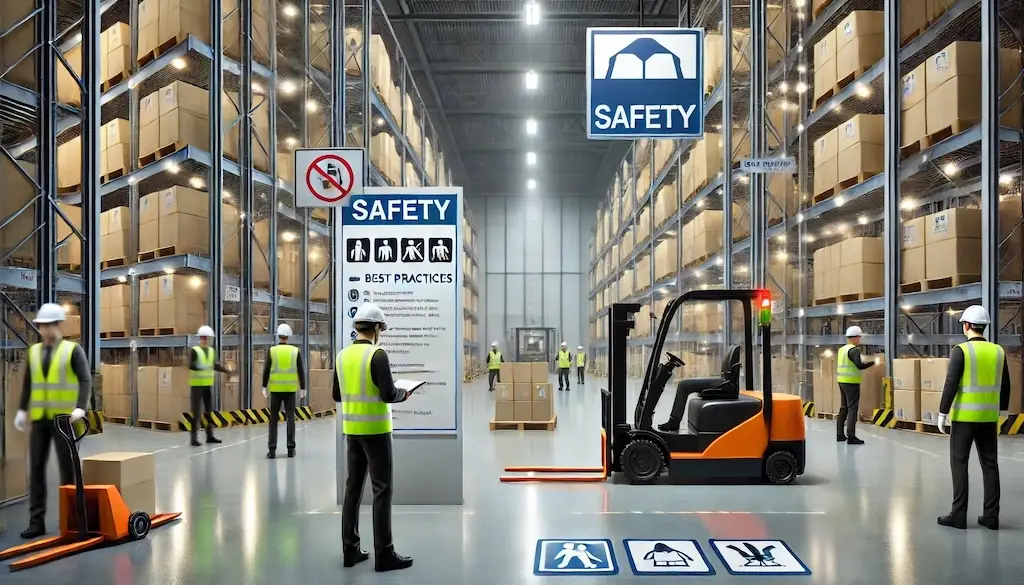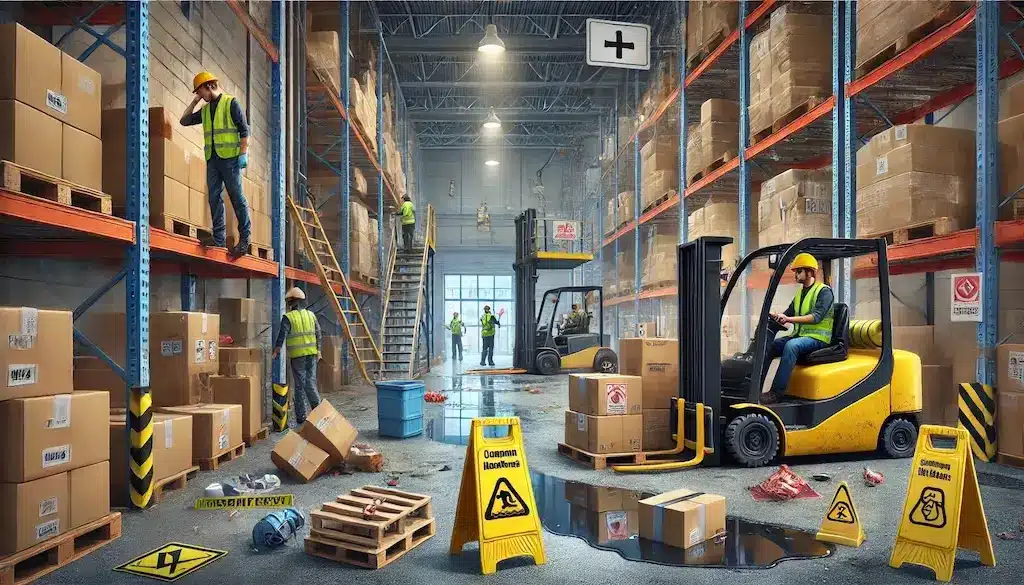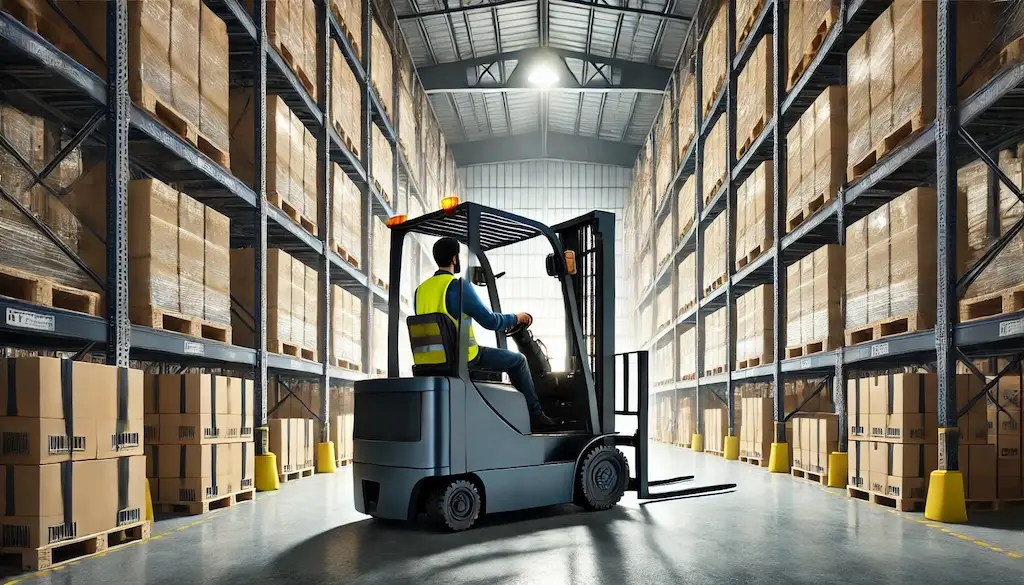
How can you ensure your warehouse is safe for employees? This article covers seven essential tips for warehouse safety. You’ll learn how to identify hazards, implement effective training, and use protective equipment to keep your workplace secure.
Key Takeaways
- Warehouse safety is crucial to protect employees from hazards. Fatal injury rates in warehousing exceed the national workplace average, making strict adherence to safety protocols essential.
- Key hazards in warehouses include falls from heights, slips and trips, and unsafe chemical storage, highlighting the need for regular inspections and good housekeeping practices.
- Effective safety training, proper use of personal protective equipment (PPE), and established emergency action plans are critical for minimizing accidents and ensuring employee preparedness.
Understanding Warehouse Safety
Warehouse safety is vital to protect employees from potential hazards and ensure operational efficiency. The fatal injury rate in warehousing is higher than the national average, emphasizing the critical need for prioritizing health and safety in these environments. When managers and workers follow safety procedures and training, the conditions in warehouses can be significantly improved.
Ignoring safety procedures and workplace hazards leads to serious safety risks of accidents and injuries among employees. Employers, supervisors, and managers are legally required to implement and maintain safety procedures in a warehouse. Comprehensive warehouse safety training educates employees about the risks and how to control exposure to those risks.
The goal of the warehouse safety tips outlined in this post is to minimize the risk of accidents and injuries in the warehouse. Recognizing the importance of warehouse safety and the consequences of neglecting it enables operators to create a safer environment for everyone.
#1 – Identifying Common Warehouse Hazards

Warehouses have numerous hazards that can cause serious injuries or fatalities. One of the most significant dangers is falls from heights, which are responsible for a large number of workplace fatalities. Slips, trips, and falls are the most common cause of workplace injuries in warehouses, often due to poorly maintained floors or cluttered aisles.
Chemical storage practices must adhere to safety standards to prevent leaks and spills. Forklifts and other mobile equipment are involved in many warehouse injuries, making it crucial to maintain clear visibility around corners and intersections. Regular inspections of materials handling equipment can also reduce the risk of injuries.
Good housekeeping practices, such as keeping aisles and pathways clear, are essential to prevent slip and trip hazards. Addressing these common hazards can significantly enhance workplace safety.
#2 – Essential Personal Protective Equipment (PPE)
Personal protective equipment (PPE) is essential in shielding employees from hazards in the workplace. Common PPE includes:
- Hard hats
- Gloves
- Safety glasses
- High-visibility apparel
- Steel-toed boots
These items are designed to protect warehouse workers from injuries and ensure safety during warehouse equipment operations.
Workers must wear appropriate PPE and follow proper training and guidance to ensure safety. For instance, protective gloves are essential to prevent cuts and injuries when handling materials. Safety glasses protect the eyes from flying debris, while safety shoes provide protection against heavy objects.
Prioritizing the use of PPE and ensuring proper training for employees can create a safer working environment and lower injury risks.
#3 – Fire Safety Measures
Conducting a comprehensive fire risk assessment helps identify potential hazards, including flammable materials and unsafe storage practices. Adhering to storage guidelines for flammable materials is crucial to minimize fire hazards. Fire extinguishers and sprinkler systems are key measures to prevent fires in warehouses.
Installing effective fire detection and alarm systems is crucial for early warning in case of fire. Regular maintenance and testing of fire suppression systems, such as sprinklers and extinguishers, ensure they function properly. Regular inspections by fire safety professionals help to ensure compliance with safety codes and the effectiveness of fire safety measures.
Keeping aisles and pathways clear prevents rapid fire spread and ensures clear emergency exits. Conducting fire drills is essential to check alarms and update evacuation plans. Implementing these fire safety measures helps protect resources and employees from the devastating effects of fires.
#4 – Best Practices for Vehicle Safety

Forklift operators should be trained to recognize hazards associated with their operation. Safe forklift operation is a critical component of training programs. Speed limit signs in the warehouse remind drivers to maintain a safe driving speed, reducing the risk of accidents.
Regular vehicle maintenance and inspections are crucial to ensure safe operation. Forklift operators should avoid reversing whenever possible and use designated routes to prevent collisions. Using mirrors can greatly enhance a driver’s visibility, especially when navigating tight corners.
Establishing a zero-tolerance policy against reckless driving can improve safety in the warehouse. Maintaining clear aisles free of obstructions is essential for safe vehicle movement. Providing operators with a daily checklist can help ensure all vehicle safety features are functional.
#5 – Proper Training and Safety Procedures
Effective safety training significantly reduces the risk of accidents and injuries in warehouses. Training for health and safety is a legal requirement in warehouses and essential for maintaining a safe working environment. Warehouse training programs need to include health and safety topics. This should encompass hazard identification, emergency response, and the proper use of equipment.
Regular fire safety training promotes awareness and preparedness among warehouse employees in case of emergencies. Training on the proper use of PPE is crucial to ensure worker safety and mitigate potential hazards. Establishing a safety-oriented culture encourages employees to engage in safe practices and report hazards without fear of retribution.
Regular safety meetings enhance engagement and foster a safety culture focused on safety among employees. Regular assessments and updates of safety protocols are essential for adapting to changes in warehouse operations. Compliance with OSHA training regulations is crucial to minimize workplace injuries and ensure legal safety standards.
#6 – Emergency Preparedness and Response
In warehouses, having a detailed Emergency Action Plan (EAP) is crucial for guiding employees during emergencies. An effective emergency plan can uncover hidden hazards and resource shortages within the organization. Regularly practicing emergency drills helps ensure that employees are familiar with their roles and responsibilities in a crisis.
Emergency exits in warehouses should be clearly signposted and kept free from obstacles to facilitate quick evacuation. The plan should include procedures for fire emergencies, chemical spills, and other potential hazards, ensuring that all employees know how to respond effectively.
Focusing on emergency preparedness and response helps warehouse managers protect employees and minimize the impact of unexpected events.
#7 – Regular Safety Audits and Inspections
The purpose of regular safety audits and inspections in warehouses is to maintain a safe warehouse by assessing safety practices and identifying potential hazards. Regular audits and inspections contribute to warehouse safety by promoting continuous improvement and reinforcing commitment to safety.
Inspections focus on identifying and addressing potential hazards like faulty equipment and unsafe storage during warehouse safety evaluations. Regular inspections can reveal potential hazards such as equipment malfunctions or ergonomic issues before they result in accidents.
Implementing safety measures can lead to a significant reduction in workplace injuries and associated costs. Regular safety audits and inspections ensure a safer working environment for employees.
Summary
Warehouse safety is a crucial aspect of maintaining a productive and efficient work environment. From understanding the importance of safety to identifying common hazards, using PPE, implementing fire safety measures, ensuring vehicle safety, providing proper training, and preparing for emergencies, these warehouse safety tips outlined in this post are essential for protecting workers and minimizing risks.
By prioritizing safety and conducting regular audits and inspections, warehouse managers can create a culture of safety that benefits everyone involved. Remember, a safe warehouse is a productive warehouse. Stay vigilant, stay safe, and always prioritize safety in your warehouse operations.
Ensure Warehouse Safety with Argos Software
Warehouse safety is critical—not just for compliance but for the well-being of your employees and the efficiency of your operations. Argos Software provides advanced warehouse management solutions that help streamline safety protocols, track equipment maintenance, and ensure compliance with industry regulations.
- Optimize safety procedures with real-time data
- Identify and mitigate hazards before they become risks
- Ensure OSHA compliance with automated tracking tools
Take the next step toward a safer, more efficient warehouse. Discover how Argos Software can help you enhance workplace safety today.
Related:
Warehouse Security Threats: Theft
Warehouse Security Threats: Physical Security
Warehouse Security Part 3: Cybersecurity
Frequently Asked Questions
What are the safety precautions in a warehouse?
To ensure safety in a warehouse, always cut away from your body when opening boxes and conduct a workstation check before starting. Additionally, promptly dispose of trash to prevent trip hazards, and remember to stop and look both ways before entering the main lanes.
What are the 5S safety steps in warehousing?
5S in warehousing focuses on five principles: sort, set, shine, standardize, and sustain, which together create a cleaner, more organized, and efficient workspace. Implementing these principles enhances safety and productivity in warehousing operations.
Why is warehouse safety important?
Warehouse safety is essential to protect employees from hazards and minimize the risk of injuries, thereby ensuring operational efficiency and a productive work environment.
What are the common hazards in a warehouse?
Common warehouse hazards include falls from heights, slips and trips, chemical spills, and forklift accidents. It is crucial to implement safety measures to prevent these risks.
What is the role of PPE in warehouse safety?
PPE is essential in warehouse safety as it protects workers from injuries through the use of hard hats, gloves, safety glasses, and steel-toed boots. This protective equipment is crucial for maintaining a safe working environment.




